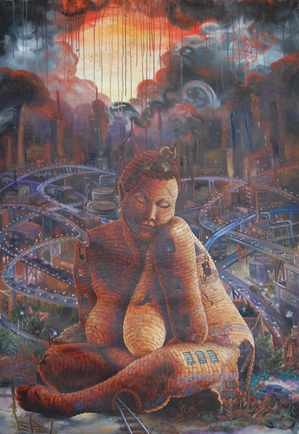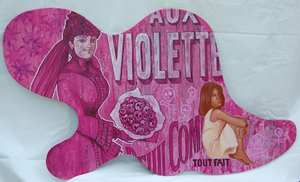This is an archive of the ArtCat Zine, 2007-2009. Please visit our new project, IDIOM.
Brick Ladies at Ad Hoc Art
Lady Pink and Aiko: Brick Ladies of NYC
Ad Hoc Art - 49 Bogart Street, Brooklyn NY
21 March - 20 April 2008
The work of Lady Pink will be on view at the Ad-Hoc Art Center in Brooklyn until April 21st. This legend of New York's graffiti scene shares the show with a younger counterpart, Aiko, who is also a rising star.
Lady Pink came of age in the old New York of the 1970s and 1980s. She made her name as the first major woman graffiti artist who held her own against the male competition when it came to gracing (or vandalizing) the trains with new designs. The city's graffiti gang would siege the MTA train yards at night, evade transit police, and write on the trains. Today's shiny silver metal subway cars were actually specifically designed to accommodate a chemical solution that can swiftly rinse off any graffiti. The old trains received a coat of red paint and were therefore a far better canvas for spray paint.
Much of the general public view spray painted trains as vandalized signs of urban decay. Those with eye for Graffiti experienced sublime suspense as the headlight shined in the distance. It would always be a surprise to see "whose" subway would pull into the station. Would it be a design that had been plowing through the tunnels for a couple of weeks? Would it be new work that was just done last night? This was the golden age of New York Graffiti.
Giuliani brought this era to end when he took office and set about to Disneyfy New York. He empowered the police to pursue more aggressive and vindictive tactics against the graffiti artists in Train Yards. A new fleet of subway cars resisted spray paint and sealed the deal. Graffiti artists responded by focusing on other spaces throughout the city. However, there was no urban surface that could compete with the subway car's visibility.
Some graffiti artists like Pink crossed over into producing pictures for the fine art world. Perhaps such a shift comes naturally as this generation ages and can no longer pull all nighters in the train yards with the same ease.
Lady Pink brings the experience of writing on the trains to the canvas as she paints with acrylics. After working with the bold and bright colors of Spray paints for many years, she continues to gravitate towards a vivid palette. She also invests in depicting small and linear details, which is another characteristic of the graffiti style. The theme of decomposing structures, which were her prime sites, appears frequently in her work.
In Queen Matilda, Lady Pink depicts a surrealistic city on a hill over which one of her architectural brick women as queen and fortress looms. Her love for detail abounds in small architectural details and flourishes that she packs in. Brightly colored cars circle round the cliffs at the base. Stained glass windows shimmer as the Queen's nipples. A subway track dynamically zig zags through the composition.
Graffiti Tags from other artists adorn the calf of the queen and the subway train. A certain virtuoso is legible here precisely because it can be difficult to copy the style of another artist's tags so perfectly. This is one of Pinks trademarks and each copied tag is a friendly tribute to a fellow artist.
The subject of Queen resonates with the artist's own biography. Her unique position as one of the few prominent woman artist in the graffiti scene gave rise to her reputation as its Queen. In an era that is hungry for feminist role models, many commentators have championed her in this light. This is not the artist's frame of reference. Her primary agenda remains the creation of fascinating work far more than forwarding a social political agenda. Nevertheless, she has embraced this coronation as an opportunity to mentor younger artists and serves as role model. Much as she depicts the Queen in her own stylistic terms, she has embraced this regal social role on her terms as well.
Lady Pink dreams up new paintings at the sketch book. It is here that she is able to work out an idea and bring from the moment of inspiration to an intricate composition. For example, an opulent and detailed dress of Queen Elizabeth 1 inspired Pink and sparked the process that culminated in Queen Matilda.
In front of the canvas, the artist builds up her pictures in a manner that is reminiscent of Old Masters like Titian. She starts with a basic coat of a certain color and then begins to build up details by one section of the
canvas at a time. This early stage of color field was left without the level of detail in Lovely Entrapment, which juxtaposes another Brick Lady against a pink background. The sharp lines of this Brick woman contrasts with the soft lines of the wash. A subtle pink flame seems to flicker in the washes undulations. The figure is based upon a goddess figure from Cambodian Ruins. The blue floral flourishes add formal interests are a painterly form of the swirling lines of graffiti.
Urban Decay was another captivating canvas in the show that depicts a primal earth mother as a Brick Lady in front of labyrinth of intersecting freeways. Stormy gray clouds surround a lone patch of bright orange sky. It speaks to the artist's project of revitalizing a dejected urban landscape with flourishes of graffiti. The work tapes into that fascination with post-industrial dystopia. The contrast between the hyperactivity of the city and the serenity of the goddess is reinforced by the background's haze and the sharp lines of the figure n the foreground.
Lady Prink remarked to your commentator that "If everything was shiny and sterile, things would be pretty scary." It is an adamant rejection of sterility of modernism that the artist cultivated long before it was fashionable. Lady Pink never went to art school. Her style was honed in the train yards of New York. The work continues to deeply resonate with a city that much like Brick woman in Urban Decay is seeking a moment of serenity amidst the industrialized hyperactivity.
ZINE
HOME
TIPS / COMMENTS
CATEGORIES
CONTRIBUTORS
- Greg Afinogenov
- B. Blagojevic
- Adda Birnir
- Susannah Edelbaum
- Julie Fishkin
- Paddy Johnson
- Jessica Loudis
- Christopher Reiger
- Andrew Robinson
- Peter J. Russo
- Blythe Sheldon
- S.C.Squibb
- Hrag Vartanian


